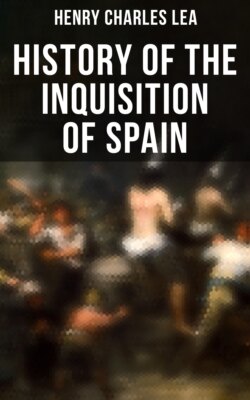History of the Inquisition of Spain

Реклама. ООО «ЛитРес», ИНН: 7719571260.
Оглавление
Henry Charles Lea. History of the Inquisition of Spain
History of the Inquisition of Spain
Table of Contents
Volume 1
BOOK I. ORIGIN AND ESTABLISHMENT
CHAPTER I. THE CASTILIAN MONARCHY
CHAPTER II. THE JEWS AND THE MOORS
CHAPTER III. THE JEWS AND THE CONVERSOS
CHAPTER IV. ESTABLISHMENT OF THE INQUISITION
NAVARRE
CHAPTER V. THE KINGDOMS OF ARAGON
VALENCIA
ARAGON
CATALONIA
THE BALEARIC ISLES
BOOK II. RELATIONS WITH THE STATE
CHAPTER I. RELATIONS WITH THE CROWN
CHAPTER II. SUPEREMINENCE
CHAPTER III. PRIVILEGES AND EXEMPTIONS
CHAPTER IV. CONFLICTING JURISDICTIONS
CHAPTER V. POPULAR HOSTILITY
APPENDIX
I. LIST OF TRIBUNALS
II. LIST OF INQUISITORS-GENERAL
III. SPANISH COINAGE
DOCUMENTS. I
II. Edict of May 30, 1492, Regulating Settlements with the Expelled Jews
III. Torquemada’s Instructions to Inquisitors, Dec., 1484.[1339]
IV. Torquemada’s Instructions To Inquisitors, Jan., 1485.[1340]
V. Instructions of Seville, 1500.[1341]
VI. Extracts from the Register of the Receiver of Confiscations at Valencia, 1485–1486
VII. Brief of Julius II Respecting the Troubles in Cordova
VIII. Proposition Made in October, 1519, to Charles V to Compound for the Confiscations
IX. Memorial from Granada to Charles V in 1526
X. Bull of Sixtus IV, April 18 1482, Temporarily Reforming the Inquisition of Aragon
XI. King Ferdinand to Pope Sixtus IV, May 13, 1482
XII. Memoria de diversos Autos de Inquisicion celebrados en Çaragoça desde el ano 1484 asta el de 1502 en que se refieren las personas castigadas en ellos.[1344]
XIII. Letter of Carlos III to the Pope, December 26, 1774, asking him to concede the faculties of Inquisitor-general to Felipe Bertran, Bishop of Salamanca
XIV. Resignation of Inquisitor-general Sotomayor
XV. Extracts from the Consulta of the Council of the Inquisition, May 5, 1646, on the independent Superiority of Inquisitorial Jurisdiction over Officials
XVI. Decree of Philip IV concerning Disobedience, March 26, 1633
XVII. Proclamation on the Arrival of an Inquisitor
XVIII. Memoria de la Reforma de Ministros del Santo Oficio que hizo hacer el rey en 1646
XIX. Decree of Philip III on Quarrels between Bishops and Inquisitors
Volume 2
THE INQUISITION OF SPAIN
BOOK III. JURISDICTION
CHAPTER I. HERESY
CHAPTER II. THE REGULAR ORDERS
CHAPTER III. BISHOPS
CHAPTER IV. THE EDICT OF FAITH
CHAPTER V. APPEALS TO ROME
BOOK IV. ORGANIZATION
CHAPTER I. THE INQUISITOR-GENERAL AND SUPREME COUNCIL
CHAPTER II. THE TRIBUNAL
CHAPTER III. UNSALARIED OFFICIALS
CHAPTER IV. LIMPIEZA
BOOK V. RESOURCES
CHAPTER I. CONFISCATION
CHAPTER II. FINES AND PENANCES
CHAPTER III. DISPENSATIONS
CHAPTER IV. BENEFICES
CHAPTER V. FINANCES
BOOK VI. PRACTICE
CHAPTER I. THE EDICT OF GRACE
CHAPTER II. THE INQUISITORIAL PROCESS
CHAPTER III. ARREST AND SEQUESTRATION
CHAPTER IV. THE SECRET PRISON
CHAPTER V. EVIDENCE
CHAPTER VI. CONFESSION
APPENDIX OF DOCUMENTS
I
II
III
IV
V
VI
VII
VIII
IX
X
XI
XII
XIII
XIV
XV
XVI
XVII
FOOTNOTES:
Volume 3
THE INQUISITION OF SPAIN
BOOK VI. (Continued)
CHAPTER VII. TORTURE
CHAPTER VIII. THE TRIAL
BOOK VII. PUNISHMENT
CHAPTER I. THE SENTENCE
CHAPTER II. MINOR PENALTIES
REPRIMAND
ABJURATION
EXILE
RAZING HOUSES
SPIRITUAL PENANCES
UNUSUAL PENALTIES
CHAPTER III. HARSHER PENALTIES
THE SCOURGE
VERGÜENZA
MORDAZA
THE GALLEYS
RECONCILIATION
THE PERPETUAL PRISON
THE SANBENITO
DISABILITIES
CLERICAL OFFENDERS
CHAPTER IV. THE STAKE
CHAPTER V. THE AUTO DE FE
BOOK VIII. SPHERES OF ACTION
CHAPTER I. JEWS
CHAPTER II. MORISCOS.[867]
CHAPTER III. PROTESTANTISM
CHAPTER IV. CENSORSHIP
APPENDIX. STATISTICS OF OFFENCES AND PENALTIES (See p. 93)
Offences
Punishments
DOCUMENTS
I
II
III
IV
V
VI
VII
VIII
IX
X
XI
XII
Volume 4
THE INQUISITION OF SPAIN
BOOK VIII. (Continued)
CHAPTER V. MYSTICISM.[1]
CHAPTER VI. SOLICITATION
CHAPTER VII. PROPOSITIONS
CHAPTER VIII. SORCERY AND OCCULT ARTS
CHAPTER IX. WITCHCRAFT
CHAPTER X. POLITICAL ACTIVITY
CHAPTER XI. JANSENISM
CHAPTER XII. FREE-MASONRY
CHAPTER XIII. PHILOSOPHISM
CHAPTER XIV. BIGAMY
CHAPTER XV. BLASPHEMY
CHAPTER XVI. MISCELLANEOUS BUSINESS
Marriage in Orders
Personation of Priesthood
Personation of Officials
Demoniacal Possession
Insults to Images
Uncanonized Saints
The Immaculate Conception
Unnatural Crime
Usury
Morals
The Seal of Confession
General Utility
BOOK IX. CONCLUSION
CHAPTER I. DECADENCE AND EXTINCTION
The Bourbons
The Cortes
The Restoration
The Revolution of 1820
Ten Years of Reaction
Cristina
CHAPTER II. RETROSPECT
APPENDIX
I
II
III
IV
V
VI
VII
VIII
IX
FOOTNOTES:
Отрывок из книги
Henry Charles Lea
Published by
.....
MILITARY ORDERS
Another jurisdiction with which there were occasional quarrels was that of the army, for soldiers were exempt from the secular courts. In such competencias settlements were made by a junta of two members each of the Suprema and the Council of War, with final reference to the king in case of disagreement. I have happened to meet with but few cases of this and they seem never to have attained the importance of those with the secular and ecclesiastical courts. One occurred in 1629, arising from disputes with the garrison that had occupied the Aljafería since the troubles of 1591. A somewhat curious case was that of Don Fernando Antonio Herrera Calderon, of Santander, who was alguazil and familiar and who resigned, in 1641, from his military company, although warned that, by so doing during hostilities, he would be tried by the Council of War. It naturally claimed him and the Suprema endeavored to protect him.[1199] It would seem that, towards the end of the eighteenth century, the exemption of the military was causing special troubles, for a royal cédula of February 9, 1793, declares that, to put an end to them, in future the military judges shall have exclusive cognizance of all cases, civil and criminal, in which soldiers are defendants, except inheritances, and that no tribunal or judge of any kind shall form a competencia concerning them under any pretext.[1200]
.....